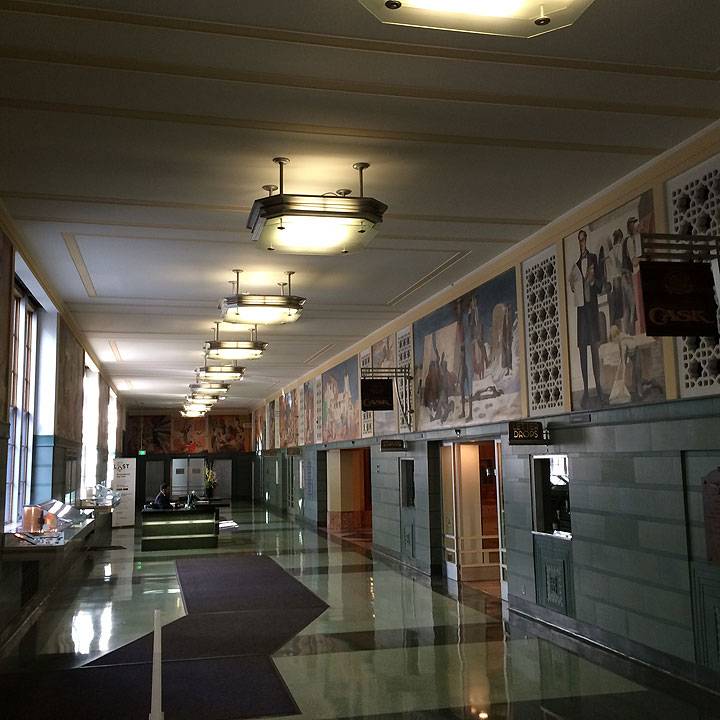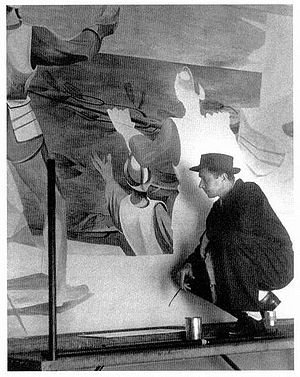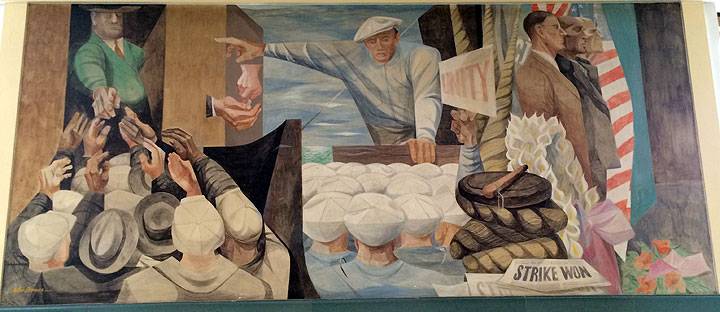Trial of the Rincon Annex Murals
Historical Essay
by Gray Brechin
Rincon Annex lobby, restored and open 24 hours but no longer a post office. The murals encircle the upper walls of the lobby.
Photo: John Horn
On the morning of May 1, 1953, the House Committee on Public Works convened in Washington, D.C., to debate the destruction of one of the largest and most expensive artworks ever commissioned by the federal government.(1) The artist Anton Refregier, according to Republican Representative Hubert Scudder of Sebastopol, California, had foisted upon the American taxpayer propaganda designed to slander the state's pioneers and convert patrons at San Francisco's main post office to communism.(2) In its daylong deliberations, the committee put history, as well as art, on trial.
Refregier was too modern, according to his accusers, for whom "modern art" was an imprecise but pejorative term covering form, or content, or both, as it served their purposes. Modern art was alternately incomprehensible and reprehensible, degenerate, or left-wing. Because they admitted at times that they were not sure just what it was, they felt safer saying what it was not ; modern art was not academic and thus did not support the social order and the state. In his subject matter, at least, Refregier had transgressed the official canon.(3)
To comprehend that day's strange events, one must understand not only the paranoia of the cold war but the near-Confucian reverence descendants of the California pioneers lavished on their ancestors. Ever since the Bear Flag Revolt of 1846 Anglo-Californians had envisioned their land as a mountain-walled principality, more nation than state. By California's fiftieth anniversary, in 1900, press and orators often compared the argonauts of 1849 to the founders of Rome. Artists were commissioned to pay them homage. In 1905 Daniel Burnham proposed a colossal monument for the summit of Telegraph Hill. For the 1915 world's fair, a permanent 850-foot Tower of the Pioneers was planned for Land's End. The tower was scrapped for lack of funds, but the exposition, as Secretary of the Interior Franklin Lane noted, was itself a monument to the superhuman valor and energy of the state's early settlers.
That the West was a place of unusual rapacity and violence and gold more a curse than blessing had been noted by visitors from the opening of the Gold Rush. The banker William Tecumseh Sherman observed sourly in 1856 that "the very nature of the country begets speculation, extravagance, failures, and rascality." Frederick Law Olmsted told San Franciscans in 1866 that a great public park would help to "overcome the dead weight of indifference to all municipal improvements which is characteristic of the transient speculative class." Joshua Speed, a close friend of Abraham Lincoln, recorded while traveling in California in 1876 that money was the universal yardstick of worth: "They measure everything by the gold standard, men as well as mules. You never hear of Mr. Smith as a good man, or Mr. Brown as an honest man, or Mr. Jones as a Christian, but Mr. S has twenty thousand million and so on. The more he has, the better he is—and it matters not how he got it, so he has it."(4)
Such harsh judgments were drowned by the percussion and brass of official civic mythmaking. The industrialist Joseph Donohue Grant, son of a pioneer dry goods magnate, answered all would-be knockers in his 1931 autobiography. Of empire builders such as his father, he wrote:
Alert, high-spirited, warmhearted—those who constituted the population of early San Francisco were gentlemen adventurers outshining in brilliance similar coteries in older communities. What a libel to speak of a greed for gold bringing such men to California! They came as searchers after larger opportunities, to a new land abundantly rich because they made it so. No more openhanded people ever lived.(5)
In the heroic generosity, intelligence, and virility of the pioneers, Grant and his set found ample proof of the survival of the fittest and thus of their rightful place at the apex of the West's financial and social pyramid. In their traditional role as patrons, such aristocrats expected artists to reflect and support their certainty according to the academic tradition, in which history was depicted as a triumphal march undeterred by border skirmishes. Among a growing number of artists who rejected that tradition after the trauma of the Great War was Anton Refregier.
Although even the depression could not shake Grant's granitic confidence, the foundation myths crumbled for millions of Americans who suddenly found themselves near starvation in the Promised Land. By 1934 the socialist Upton Sinclair's grassroots campaign for governor had grown so serious that an unprecedented (and pioneering) smear campaign was required to defeat him and to elect the unpopular Frank Merriam in his place.(6) In the same year, conditions along the waterfronts of the West Coast grew so desperate that longshoremen walked out on what little work they had. Governor Merriam placed San Francisco under martial law and sent tanks to patrol the Embarcadero. The Pacific Maritime Strike culminated in a pitched battle in San Francisco between pickets and police. Two workers were shot and killed in a fusillade at the foot of Rincon Hill. Within days, forty thousand men marched silently down Market Street (Fig. 23) in one of the largest funeral processions in city history.(7)
The general strike that followed shut down the city for four days, precipitating a rain of phone calls and telegrams to Washington claiming that revolution had begun on the Pacific Coast. The alarms helped persuade President Roosevelt and his brain trust to accelerate their public works programs to short-circuit any such possibility. No one has ever inventoried the New Deal's legacy of public works for the Bay Area alone, but it would include paved roads, sewers, forests, parks, schools, and theaters, as well as a myriad of federal art projects.(8)
Prior to the crash, virtually all public art had endorsed the benignity and legitimacy of the American Dream. No market existed for artists who might question it. But in 1934, in the depth of the depression, President Franklin Roosevelt opened a window for those who might dissent, giving them both patronage and exhibition space without precedent in the United States.
Roosevelt's experiment in federal art sponsorship began at the suggestion of his Groton and Harvard classmate George Biddle. A painter himself, Biddle first proposed to the president in 1933 that the government provide relief for American artists. Biddle hoped to create the seedbed for an American renaissance. He later wrote of the Works Progress Administration Federal Art Project: "Its credo is that if one creates a cultural background, art will follow. It wasn't Michelangelo who created the 15th century but the 15th century that created Michelangelo."(9) The conservative Commission of Fine Arts, created by Congress in 1910 to advise the government on artistic matters, recommended against Biddle's proposal in a report to the president, fearing trouble from modern muralists who professed "a general faith which the public does not share," one that ignored "the established tradition . . . fostered by the American Academy at Rome."(10)
The Public Works of Art Project (PWAP) and the other programs that followed it initiated controversies that outlived Roosevelt by many years as a minority of left-wing artists tested the First Amendment and reactionaries, in turn, cited the right of taxpayers not to be insulted or indoctrinated by "radicals." Guardians of tradition and morality like the National Society for Sanity in Art, founded by the Chicago socialite Josephine Hancock Logan, along with its regional affiliates and the Hearst press, carefully scrutinized the new public art for symptoms of modernist "decadence" or the un-American content usually equated with it.(11)
The federal art projects never received the popular support Roosevelt himself enjoyed. The president created them by executive fiat, leaving representatives to deal with their irate constituents.(12) Nor did Biddle help. The aristocratic artist enjoyed needling powerful domestic opponents: "The most serious threat to the success of life of the Project," he wrote after much experience, "is the high emotional level and the low mental caliber of our Congressmen."(13)
Biddle looked to Mexico for a model of government art patronage, but in doing so he ignored the radically different political climate of the neighboring nation. By 1934 privately commissioned works by two Mexican muralists had amply demonstrated the uproar that allegedly subversive subject matter could cause in the United States. In 1930 José Clemente Orozco completed his mural Prometheus in the Pomona College dining hall, despite vigorous attacks from college trustees and local newspapers alarmed by what they perceived as their revolutionary content. Four years later, Nelson Rockefeller ordered stripped from the lobby at Rockefeller Center Diego Rivera's mural Man at the Crossroads, whose numerous unorthodoxies included a portrait of Lenin as well as syphilis spirochetes swimming toward a swank dinner party in what was intended to be a cathedral of capitalism.
On an extended visit to paint murals in San Francisco during the early 1930s, Rivera had strongly influenced many of the artists whom the government would later commission to decorate the walls of the new Coit Memorial Tower on Telegraph Hill. Edward Bruce, head of the PWAP, hoped that the tower's murals would serve as a pilot demonstration of how federal patronage could enrich the nation's cultural life. Their theme was "Aspects of Life in California, 1934"—a bad year, as it turned out, for officially sanctioned subject matter.(14)
In mid-February, the San Francisco Artists' and Writers' Union met at the unfinished tower to protest "the outrageous vandalism and political bigotry" represented by the destruction of Rivera's New York mural. Their activism only drew attention to what they themselves were creating. Reporters from the major press quickly discovered subtle heresies in the tower's murals meant to undermine the national faith. In a large street scene, for example, Victor Arnautoff had replaced the San Francisco Chronicle with the Daily Worker and the Masses. Browsers in Bernard Zakheim's Library were choosing Das Kapital rather than The Wealth of Nations. Worst of all, Clifford Wight had included, without permission from the regional PWAP chairman, Dr. Walter Heil, a hammer and sickle as emblematic of one economic choice available to Americans in the 1930s.
In his capacity as director of the M. H. de Young Memorial Museum, Hell was unaccustomed to the controversies of art in action. He wired Washington that "editors of influential newspapers . . . have warned us they would take [a] hostile attitude towards [the] whole project unless these details be removed." Edward Bruce responded that he hoped the artists "don't fool around with this Socialistic thing any longer," and advised Hell to "wipe the damn painting out of the Tower."(15) Making good on its promise to Heil, the Hearst-owned San Francisco Examiner carried a nationally syndicated photograph of Wight's symbol crudely spliced onto Zakheim's Library.(16) The doctored photo appeared on July 5, 1934, the day the strikers were killed at Rincon Hill. So intense did the controversy become, and so closely linked was it to the events on the waterfront below Telegraph Hill, that the city Park Commission ordered Coit Tower locked, ostensibly to prevent vandalism. It was reopened on October 20, 1934, after passions had cooled. By that time, Wight's symbol had mysteriously vanished.
Evelyn Seeley, reporting on the Coit controversy, felt it was a tempest in a teapot. "In the main, [the artists] presented California as powerful and productive, its machines well-oiled, its fields and orchards bountiful, its people happy in the sun." In a comment prophetic of those made in the thick of the Rincon Annex controversy, she added, "They have left out of the picture, as some realists have mentioned, such aspects as the Mooney case, or strikes or lynchings."(17)
The Coit Tower controversy did not end government patronage. Rather, New Deal programs proliferated in the years that followed. Of the art bureaucracies that followed the PWAP, the Treasury Section of Painting and Sculpture (known simply as the Section) offered the most prestigious and lucrative prize.(18) Created by executive order of Treasury Secretary Henry Morgenthau on October 14, 1934, the Section would ensure high-caliber work in public buildings by selecting artists in juried competitions. In 1940 a Section jury chose Anton Refregier, of Woodstock, New York, from among eighty-two contestants, to decorate a new post office in San Francisco. The government agreed to pay Refregier $26,000 to design and paint a chronological history of the city in twenty-seven panels totaling 2,574 square feet. A delighted Refregier told reporters that he had worked five solid months preparing his designs. What he did not tell them was that he would paint just those "realist" subjects that Evelyn Seeley said had been left out of Coit Tower.
A strong-minded outsider, Refregier also told the Chronicle when he arrived in San Francisco that he wanted to paint the past, not as a romantic backdrop, but as part of the living present, a present shaped by the trauma of depression, strikes, and impending war. He did not, he added, believe that the miners of 1849 wore gardenias, and he saw no reason to paint them as if they did.(19) In these desires and beliefs Refregier was modern, differing sharply from both working-class patriots and ancestor-proud patricians such as Joseph Donohue Grant. World War II, however, interrupted the Rincon Annex project, while Roosevelt's death virtually ended the brief experiment in federal patronage. By the time Refregier returned to San Francisco in 1946, the Section was being phased out and responsibility for its outstanding projects transferred to the Public Buildings Administration.
Refregier's highly ambitious program was traditional enough. He envisioned representing the entire span of human civilization in the brief history of San Francisco. In the cycle as originally conceived in 1940, the artist had intended to begin with a California Indian creating a primitive work of art and to proceed through a sequence of conflicts to the 1939 Treasure Island world's fair celebrating peace in the Pacific. Following the armistice, he changed the last panel to a three-part composition representing the war, the Four Freedoms, and the founding of the United Nations. Refregier had covered the latter event in San Francisco for Fortune magazine.
Controversy began before the Rincon paintings were finished.(20) The Catholic Church protested that a friar preaching to Indians at Mission Dolores was too fat; Refregier slimmed him. In 1947 the Public Buildings Administration ordered Refregier to take President Roosevelt out of his panel The Four Freedoms. The artist claimed that a Republican Congress had initiated a campaign to discredit the late president and the legacy of his New Deal.(21) Although he called on the people of San Francisco to support his refusal to carry out the order, he eventually complied.(22) His troubles had only begun.
By the spring of 1948 the Veterans of Foreign Wars were protesting Refregier's depiction of the maritime strike and the funeral for the strikers killed across the street from the Rincon Annex Post Office. Fourteen years after the strike and killings, those events were still raw in local memory. According to the VFW, the strike leader rallying massed workers in Refregier's painting appeared to be the suspected communist Harry Bridges. He points accusingly at a hiring boss taking bribes in the notorious "shape-up system" that prevailed before the strike won longshoremen the right to a union hiring hall.(23) The artist may as well have tossed gasoline onto a guttering campfire. "The stories in the Hearst press," he later wrote, "brought out gangs of hoodlums who were constantly under my scaffolding and I no longer worked after the sun set."(24)
'Portrayal of the 1934 Maritime Strike, though historically inaccurate (no headlines screamed "Strike Won!" at end of strike!)
Mural: Anton Refregier, photo: John Horn




